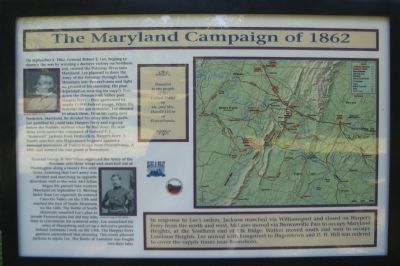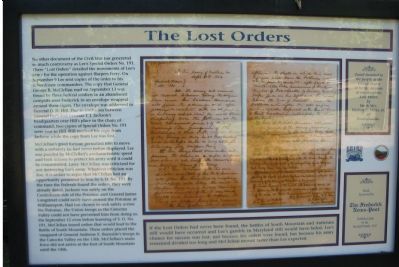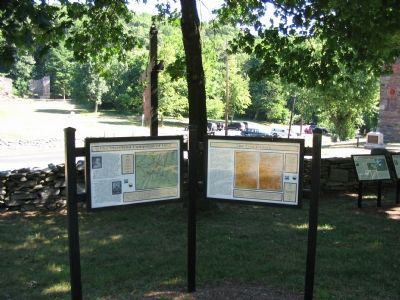Near Burkittsville in Frederick County, Maryland — The American Northeast (Mid-Atlantic)
Maryland Campaign of 1862 / The Lost Orders
On September 4, 1862, General Robert E. Lee, hoping to shorten the war by winning a decisive victory on Northern soil, crossed the Potomac River into Maryland. Lee planned to draw the Army of the Potomac through South Mountain into Pennsylvania and fight on ground of his choosing. His plan depended on securing his supply line down the Shenandoah Valley past Harpers Ferry—then garrisoned by nearly 13,000 Federal troops. When the Federals did not withdraw, Lee decided to attack them. From his camp near Frederick, Maryland, he divided his army into five parts. Lee gambled he could take Harpers Ferry and regroup before the Federals realized what he had done. He sent three units under the command of General T. J. “Stonewall” Jackson from Frederick to Harpers Ferry. A fourth marched into Hagerstown to guard against a rumored movement of Union troops from Pennsylvania. A fifth unit formed the rear guard at Boonesboro.
General George B. McClellan organized the Army of the Potomac into three wings and marched out of Washington along a twenty-five mile front. Learning that Lee's army was divided and marching in opposite directions well to the west, McClellan began his pursuit into western Maryland on September 11. Moving faster than Lee expected, he entered Catoctin Valley on the 13th and reached the foot of South Mountain on the 14th. The Battle of South Mountain smashed Lee’s plan to invade Pennsylvania but did buy him time to concentrate his scattered army. Lee assembled his army at Sharpsburg and set up a defensive position behind Antietam Creek on the 15th. The Harpers Ferry garrison surrendered that morning. This event allowed Jackson to rejoin Lee. The Battle of Antietam was fought two days later.
In response to Lee’s orders, Jackson marched via Williamsport and closed on Harper’s Ferry from the north and west. McLaws moved via Brownsville Pass to occupy Maryland Heights, at the Southern end of Elk Ridge. Walker moved south and west to occupy Loudoun Heights. Lee moved with Longstreet to Hagerstown and D. H. Hill was ordered to cover the supply trains near Boonsboro.
Donated to the people of the United States by Mr. and Mrs. Harold Litvin of Pennsylvannia.
(Right Side)
No other document of the Civil War has generated so much controversy as Lee's Special Orders No. 191. These “Lost Orders” detailed the movements of Lee’s army for the operation against Harpers Ferry. On September 9 Lee sent copies of the order to his subordinate commanders. The copy that General George B. McClellan read on September 13 was found by three Federal soldiers in an abandoned campsite near Frederick in an envelope wrapped around three cigars. The envelope was addressed to General D. H. Hill. Due to confusion between General Lee’s and General T. J. Jackson’s headquarters over Hill’s place in the chain of command, two copies of Special Orders No. 191 were sent to Hill. Hill received his copy from Jackson while the copy from Lee was lost.
McClellan’s good fortune permitted him to move with a certainty he had never before displayed. Lee was puzzled by McClellan’s uncharacteristic speed and took actions to protect his army until it could be concentrated. Later McClellan was criticized for not destroying Lee’s army. Whatever criticism was due, it is unfair to argue that McClellan lost an opportunity presented to him by S. O. No. 191. By the time the Federals found the orders, they were already dated. Jackson was safely on the Confederate side of the Potomac and General James Longstreet could easily have crossed the Potomac at Williamsport. Had Lee chosen to seek safety across the Potomac, the Union troops in the Catoctin Valley could not have prevented him from doing so. On September 12 even before learning of S. O. No. 191, McClellan issued orders that would lead to the Battle of South Mountain. These orders placed the vanguard of General Ambrose E. Burnside’s troops in the Catoctin Valley on the 13th. McClellan's main force did not arrive at the foot of South Mountain until the 14th.
If the Lost Orders had never been found, the battles of South Mountain and Antietam still would have occurred and Lee’s gamble in Maryland still would have failed. Lee’s chance for success was lost, not because his orders were found, but because his army remained divided too long and McClellan moved faster than Lee expected.
Panel donated to the People of the United States in loving memory of our daughter, Amy Miller, by Mr. and Mrs. Herbert C. Miller, Jr. of Pennsylvannia.
Kiosk Sponsored by The Frderick News-Post Published daily by the Randall Family, LLC.
Erected by Blue and Gray Education Society.
Topics. This historical marker is listed in this topic list: War, US Civil. A significant historical month for this entry is September 1841.
Location. 39° 24.339′ N, 77° 38.38′ W. Marker is near Burkittsville, Maryland, in Frederick County. Marker is at the intersection of Gapland Road and Arnoldstown Road, on the left when traveling west on Gapland Road. The Appalachian Trail passes a few feet to the west (left) of this marker. Touch for map. Marker is in this post office area: Burkittsville MD 21718, United States of America. Touch for directions.
Other nearby markers. At least 8 other markers are within walking distance of this marker. Mell Rifles & Troup Light Artillery (within shouting distance of this marker); War Correspondents Memorial Arch (within shouting distance of this marker); Battle for Crampton’s Gap (within shouting distance of this marker); George Alfred Townsend (within shouting distance of this marker); 1862 Antietam Campaign (within shouting distance of this marker); Journalists Who Gave Their Lives (within shouting distance of this marker); First New Jersey Brigade (within shouting distance of this marker); War Correspondents (within shouting distance of this marker). Touch for a list and map of all markers in Burkittsville.
More about this marker. This marker is an exact duplicate of a marker posted at Fox’s Gap (Numbers 451 and 453) and Turner’s Gap (1588). The only significant difference are the monument donation attributions.
The markers feature a battle map and pictures of Gens Robert E. Lee and George B. McClellan, on the left side. A copy of the lost orders is recreated on the right side.
Related markers. Click here for a list of markers that are related to this marker. To better understand the relationship, study each marker in the order shown.
Also see . . . The Battle of South Mountain. (Submitted on August 11, 2007, by Craig Swain of Leesburg, Virginia.)
Credits. This page was last revised on May 22, 2020. It was originally submitted on August 11, 2007, by Craig Swain of Leesburg, Virginia. This page has been viewed 1,761 times since then and 21 times this year. Photos: 1, 2, 3. submitted on August 11, 2007, by Craig Swain of Leesburg, Virginia. • J. J. Prats was the editor who published this page.


